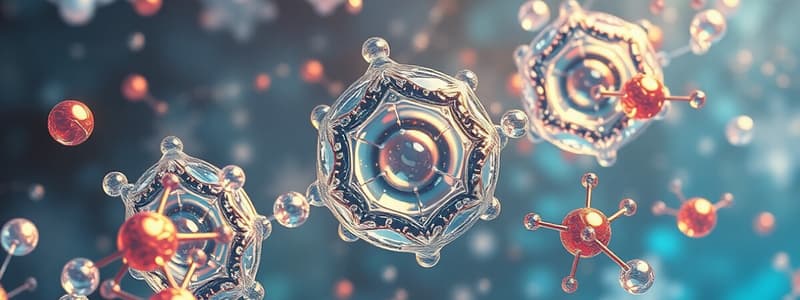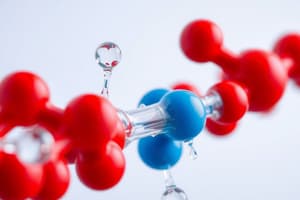Podcast
Questions and Answers
What is the primary role of enzymes in biological reactions?
What is the primary role of enzymes in biological reactions?
- To consume reactants during the reaction
- To reduce the activation energy needed for reactions (correct)
- To accelerate the rate of chemical reactions (correct)
- To change the nature of the reactants
Chemical reactions in the human body can proceed at normal rates without enzymes.
Chemical reactions in the human body can proceed at normal rates without enzymes.
False (B)
What term is used for nonprotein molecules that assist enzyme catalysis?
What term is used for nonprotein molecules that assist enzyme catalysis?
cofactors
The inactive forms of enzymes that must be processed to become active are called __________.
The inactive forms of enzymes that must be processed to become active are called __________.
Which of the following is NOT a type of RNA?
Which of the following is NOT a type of RNA?
What sugar is present in RNA?
What sugar is present in RNA?
DNA contains the bases: adenine, guanine, cytosine, and uracil.
DNA contains the bases: adenine, guanine, cytosine, and uracil.
The __________ of nucleotides gives DNA its structural shape, forming a double helix.
The __________ of nucleotides gives DNA its structural shape, forming a double helix.
Match the following enzymes to their characteristics:
Match the following enzymes to their characteristics:
What is the energy currency of cells?
What is the energy currency of cells?
What property of water allows it to regulate temperature effectively?
What property of water allows it to regulate temperature effectively?
Ice sinks in water because it is denser than liquid water.
Ice sinks in water because it is denser than liquid water.
What term describes substances that dissolve easily in water?
What term describes substances that dissolve easily in water?
Water has a unique property called _______ that allows water molecules to stick to one another.
Water has a unique property called _______ that allows water molecules to stick to one another.
Match the following properties of water with their descriptions:
Match the following properties of water with their descriptions:
What is the pH range that must be maintained in human blood?
What is the pH range that must be maintained in human blood?
Only hydrocarbons contain carbon in their structure.
Only hydrocarbons contain carbon in their structure.
What is the primary structural feature that distinguishes organic molecules?
What is the primary structural feature that distinguishes organic molecules?
Which of the following is NOT a type of lipid?
Which of the following is NOT a type of lipid?
Glycogen is a storage polysaccharide found in plants.
Glycogen is a storage polysaccharide found in plants.
What type of bond is formed between monosaccharides during dehydration synthesis?
What type of bond is formed between monosaccharides during dehydration synthesis?
Humans do not possess the enzyme to break the bonds in __________.
Humans do not possess the enzyme to break the bonds in __________.
Match the following proteins with their characteristics:
Match the following proteins with their characteristics:
Which molecule is a key component of biological membranes?
Which molecule is a key component of biological membranes?
Unsaturated fatty acids contain only single covalent C-C bonds.
Unsaturated fatty acids contain only single covalent C-C bonds.
What are the monomers of proteins called?
What are the monomers of proteins called?
Lipids represent __________ of total body mass in humans.
Lipids represent __________ of total body mass in humans.
What is the primary structure of proteins determined by?
What is the primary structure of proteins determined by?
Cholesterol is essential for the fluidity of biological membranes.
Cholesterol is essential for the fluidity of biological membranes.
What is the role of hydrogen bonds in protein structure?
What is the role of hydrogen bonds in protein structure?
The three-dimensional shape of a protein is its __________ structure.
The three-dimensional shape of a protein is its __________ structure.
Match the following polysaccharides with their main characteristics:
Match the following polysaccharides with their main characteristics:
Study Notes
Water Properties
- Water exhibits cohesion due to the hydrogen bonds between water molecules.
- Water has a high heat capacity, meaning it can absorb a lot of energy before its temperature changes significantly.
- Water expands when it freezes, making ice less dense than liquid water, allowing aquatic organisms to survive the winter.
- Water is a polar molecule, making it an excellent solvent for polar and charged substances (hydrophilic).
- Hydrophobic substances like oils and lipids do not dissolve in water.
- Buffers in water help minimize changes in pH levels, crucial for maintaining the pH of blood between 7.35-7.45.
Basic Chemistry of Life
- Matter is composed of elements and compounds.
- Organic molecules contain carbon and are essential for life.
- Hydrocarbon molecules contain only carbon and hydrogen.
- Functional groups are attached to the carbon skeleton of organic molecules and give them unique chemical properties.
Biological Molecules
- Biological molecules are complex organic compounds made up of monomers, except lipids.
- Carbohydrates:
- Contain carbon, hydrogen, and oxygen.
- Monomers are called monosaccharides, such as glucose and fructose.
- Disaccharides are formed by joining two monosaccharides.
- Polysaccharides are long chains of monosaccharides.
- Glycogen is the storage polysaccharide of animals.
- Starches are storage polysaccharides of plants.
- Lipids:
- Hydrophobic molecules containing carbon, hydrogen, and a small proportion of oxygen.
- Include:
- Fatty acids: saturated (single C-C bonds) and unsaturated (double C-C bonds).
- Triglycerides: fats (solid at room temperature) and oils (liquid at room temperature).
- Phospholipids: amphipathic molecules with a hydrophilic head and hydrophobic tails, forming cell membranes.
- Steroids: made from four fused carbon rings, including cholesterol, which is a significant component of cell membranes.
- Eicosanoids: 20-carbon compounds involved in immune signaling.
- Fat-soluble vitamins: essential nutrients such as vitamins D, E, and K.
- Proteins:
- Large molecules containing carbon, hydrogen, oxygen, and nitrogen.
- Monomers are called amino acids, which have a central carbon atom bonded to:
- Amino group
- Carboxyl group
- R group: determines the amino acid's unique chemical properties.
- Amino acids are joined by peptide bonds through dehydration synthesis, forming polypeptides.
- Protein structure determines function:
- Primary structure: the amino acid sequence.
- Secondary structure: alpha-helices and beta-sheets, stabilized by hydrogen bonds.
- Tertiary structure: the three-dimensional shape, determined by primary and secondary structures and various bonds.
- Quaternary structure: the arrangement of polypeptide chains in multi-peptide proteins.
- Proteins are classified as:
- Fibrous proteins: long, parallel bundles, insoluble in water (e.g., keratin, actin).
- Globular proteins: round or blob-like, soluble in water (e.g., antibodies, enzymes).
- Denaturation: loss of protein structure, resulting in biological inactivity.
- Enzymes:
- Biological catalysts that speed up chemical reactions without being consumed.
- Substrate: the reactant in an enzyme-catalyzed reaction.
- Active site: the region on the enzyme where substrates bind.
- Cofactors: nonprotein molecules that assist enzyme catalysis.
- Enzymes work by lowering activation energy.
- Nucleic acids:
- Contain carbon, hydrogen, oxygen, nitrogen, and phosphorus.
- Deoxyribonucleic acid (DNA): genetic material, stores and transmits genetic information.
- Ribonucleic acid (RNA): involved in protein synthesis (mRNA), ribosomal structure (rRNA), and transporting amino acids (tRNA).
- Monomers are nucleotides, composed of:
- Nitrogenous base (A, G, C, T in DNA, A, G, C, U in RNA).
- Pentose sugar (deoxyribose in DNA, ribose in RNA).
- Phosphate group.
- DNA forms a double helix, with bases pairing (A with T, G with C) and the backbone formed by sugar-phosphate groups.
- DNA replication: the process of creating a new copy of the DNA molecule.
- Adenosine Triphosphate (ATP): the energy currency of cells, composed of adenosine (adenine + ribose) and three phosphate groups. ATP is produced by exergonic reactions and consumed by endergonic reactions, with the release of energy upon hydrolysis of the terminal phosphate group.
Studying That Suits You
Use AI to generate personalized quizzes and flashcards to suit your learning preferences.
Description
Explore the fascinating properties of water and its significance to life. This quiz covers water's unique characteristics, its role in biological systems, and the fundamental components of organic molecules essential for living organisms. Test your understanding of these critical concepts in basic chemistry and biology.




